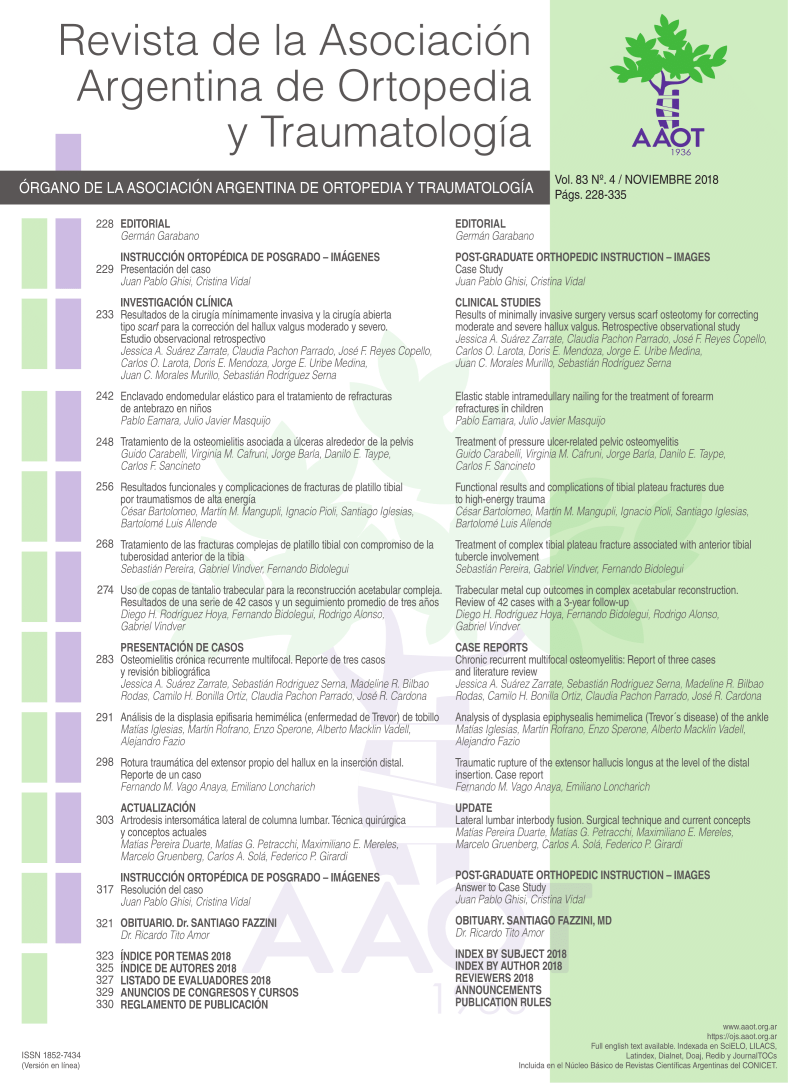Traumatic rupture of the extensor hallucis longus at the level of the distal insertion. Case report.
Main Article Content
Abstract
Downloads
Metrics
Article Details

This work is licensed under a Creative Commons Attribution-NonCommercial-ShareAlike 4.0 International License.
Manuscript acceptance by the Journal implies the simultaneous non-submission to any other journal or publishing house. The RAAOT is under the Licencia Creative Commnos Atribución-NoComercial-Compartir Obras Derivadas Igual 4.0 Internacional (CC-BY-NC.SA 4.0) (http://creativecommons.org/licences/by-nc-sa/4.0/deed.es). Articles can be shared, copied, distributed, modified, altered, transformed into a derivative work, executed and publicly communicated, provided a) the authors and the original publication (Journal, Publisher and URL) are mentioned, b) they are not used for commercial purposes, c) the same terms of the license are maintained.
In the event that the manuscript is approved for its next publication, the authors retain the copyright and will assign to the journal the rights of publication, edition, reproduction, distribution, exhibition and communication at a national and international level in the different databases. data, repositories and portals.
It is hereby stated that the mentioned manuscript has not been published and that it is not being printed in any other national or foreign journal.
The authors hereby accept the necessary modifications, suggested by the reviewers, in order to adapt the manuscript to the style and publication rules of this Journal.
References
2. Sim FH, DeWeerd JH Jr. Rupture of the extensor hallucis longus tendon while skiing. Minn Med 1977;60(11):789-90. PMID: 927409
3. McMaster PE. Tendon and muscle ruptures: clinical and experimental studies of the causes and location of subcutaneous ruptures. J Bone Joint Surg 1933;15(3):705-22. https://bit.ly/2ENigKz
4. Floyd DW, Heckman JD, Rockwood CA Jr. Tendon lacerations in the foot. Foot Ankle 1983;4(1):8-14. doi:10.1177/107110078300400103
5. Griffiths JC. Tendon injuries around the ankle. J Bone Joint Surg Br 1965;47(4):686-9. doi:10.1302/0301-620X.47B4.686
6. Berens TA. Autogenous graft169500 repair of an extensor hallucis longus laceration. J Foot Surg 1990;29(2):179-82. PMID: 1970988
7. Tachdjian MO. The child’s foot, Philadelphia: WB Saunders; 1985:456-7.
8. Menz P, Nettle WJS. Closed rupture of the musculotendinous junction of extensor hallucis longus. Injury 1989;20(6):379-81. doi:10.1016/0020-1383(89)90022-3
9. Hennessy MS, Saxby TS. Traumatic “mallet toe” of the hallux: a case report. Foot Ankle Int 2001;22(12):977-8. doi:10.1177/107110070102201209
10. Rapoff AJ, Heiner JP. Avulsion fracture of the great toe: a case report. Foot Ankle Int 1999;20(5):337-9. doi: 10.1177/107110079902000514
11. Hong CC, Tan KJ. Suture anchor fixation of unstable bony mallet injuries of the hallux. Foot Ankle Int 2013;34(12):1737-40. doi: 10.1177/1071100713499906

